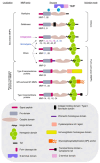Cardiovascular Biomarkers: Tools for Precision Diagnosis and Prognosis
- PMID: 40244022
- PMCID: PMC11989402
- DOI: 10.3390/ijms26073218
Cardiovascular Biomarkers: Tools for Precision Diagnosis and Prognosis
Abstract
The present study provides a detailed review of cardiovascular biomarkers critical for the diagnosis, prognosis, and pathophysiology of cardiovascular diseases, the leading cause of global morbidity and mortality. These biomarkers aid in detecting disease onset, progression, and therapeutic responses, providing insights into molecular mechanisms. Enzyme markers like AST, CK-MB, LDH, CA-III, and HBDH are pivotal for detecting myocardial injury during acute events. Protein markers such as CRP, H-FABP, and MPO shed light on inflammation and oxidative stress. Cardiac Troponins, the gold standard for myocardial infarction diagnosis, exhibit high specificity and sensitivity, while IMA and GPBB indicate ischemia and early myocardial damage. Peptide markers, including BNP and NT-proBNP, are crucial for heart failure diagnosis and management, reflecting ventricular stress and remodeling. Novel peptides like MR-proANP and MR-proADM aid in assessing disease severity. Lipid markers such as lipoprotein-associated phospholipase A2 and oxylipins provide insights into lipid metabolism and atherosclerosis. Inflammatory and stress-related biomarkers, including TNFα, IL-6, GDF-15, and Pentraxin 3, illuminate chronic inflammation in CVDs. Hormonal markers like copeptin and endothelin-1 highlight neurohormonal activation, while emerging markers such as ST2, galectin-3, PAPP-A, and TMAO elucidate fibrosis, remodeling, and metabolic dysregulation. The inclusion of microRNAs and long non-coding RNAs represents a breakthrough in biomarker research, offering sensitive tools for early detection, risk stratification, and therapeutic targeting. This review emphasizes the diagnostic and prognostic utility of these biomarkers, advancing cardiovascular care through personalized medicine.
Keywords: IL-6; TNFα; cardiac troponins; cardiovascular biomarkers; copeptin and endothelin-1; heart failure biomarkers; miRNAs.
Conflict of interest statement
The authors declare no conflicts of interest.
Figures







Similar articles
-
Advancements in Biomarkers for Early Detection and Risk Stratification of Cardiovascular Diseases-A Literature Review.Health Sci Rep. 2025 May 26;8(5):e70878. doi: 10.1002/hsr2.70878. eCollection 2025 May. Health Sci Rep. 2025. PMID: 40432692 Free PMC article.
-
Multimarker Risk Stratification in Patients With Acute Myocardial Infarction.J Am Heart Assoc. 2016 May 20;5(5):e002586. doi: 10.1161/JAHA.115.002586. J Am Heart Assoc. 2016. PMID: 27207959 Free PMC article.
-
Prognostic performance of multiple biomarkers in patients with non-ST-segment elevation acute coronary syndrome: analysis from the MERLIN-TIMI 36 trial (Metabolic Efficiency With Ranolazine for Less Ischemia in Non-ST-Elevation Acute Coronary Syndromes-Thrombolysis In Myocardial Infarction 36).J Am Coll Cardiol. 2014 Apr 29;63(16):1644-53. doi: 10.1016/j.jacc.2013.12.034. Epub 2014 Feb 13. J Am Coll Cardiol. 2014. PMID: 24530676 Clinical Trial.
-
Biomarkers and diagnostics in heart failure.Biochim Biophys Acta. 2013 Dec;1832(12):2442-50. doi: 10.1016/j.bbadis.2012.12.014. Epub 2013 Jan 9. Biochim Biophys Acta. 2013. PMID: 23313577 Review.
-
Novel Biomarkers and Their Role in the Diagnosis and Prognosis of Acute Coronary Syndrome.Life (Basel). 2023 Sep 29;13(10):1992. doi: 10.3390/life13101992. Life (Basel). 2023. PMID: 37895374 Free PMC article. Review.
Cited by
-
The Latest Advances in Omics Technology for Assessing Tissue Damage: Implications for the Study of Sudden Cardiac Death.Int J Mol Sci. 2025 Jul 16;26(14):6818. doi: 10.3390/ijms26146818. Int J Mol Sci. 2025. PMID: 40725061 Free PMC article. Review.
-
Integration of Hematologic and Metabolic Biomarkers for Outcome Prediction in Acute Coronary Syndromes Without ST Elevation.Cureus. 2025 Jun 20;17(6):e86446. doi: 10.7759/cureus.86446. eCollection 2025 Jun. Cureus. 2025. PMID: 40688843 Free PMC article.
-
Efficacy of Colchicine in Reducing Cardiovascular Events in Patients with Acute Coronary Syndrome: A Systematic Review.Cureus. 2025 Jun 20;17(6):e86424. doi: 10.7759/cureus.86424. eCollection 2025 Jun. Cureus. 2025. PMID: 40688868 Free PMC article. Review.
-
Circulating-free DNA: A promising tool for early detection of myocardial infarction.Int J Cardiol Cardiovasc Risk Prev. 2025 Aug 5;27:200484. doi: 10.1016/j.ijcrp.2025.200484. eCollection 2025 Dec. Int J Cardiol Cardiovasc Risk Prev. 2025. PMID: 40822890 Free PMC article. Review.
References
-
- Gaziano T.A. Cardiovascular diseases worldwide. Public Health Approach Cardiovasc. Dis. Prev. Manag. 2022;1:8–18.
-
- Vasan R.S. Biomarkers of cardiovascular disease: Molecular basis and practical considerations. Circulation. 2006;113:2335–2362. - PubMed
Publication types
MeSH terms
Substances
Grants and funding
LinkOut - more resources
Full Text Sources
Research Materials
Miscellaneous

